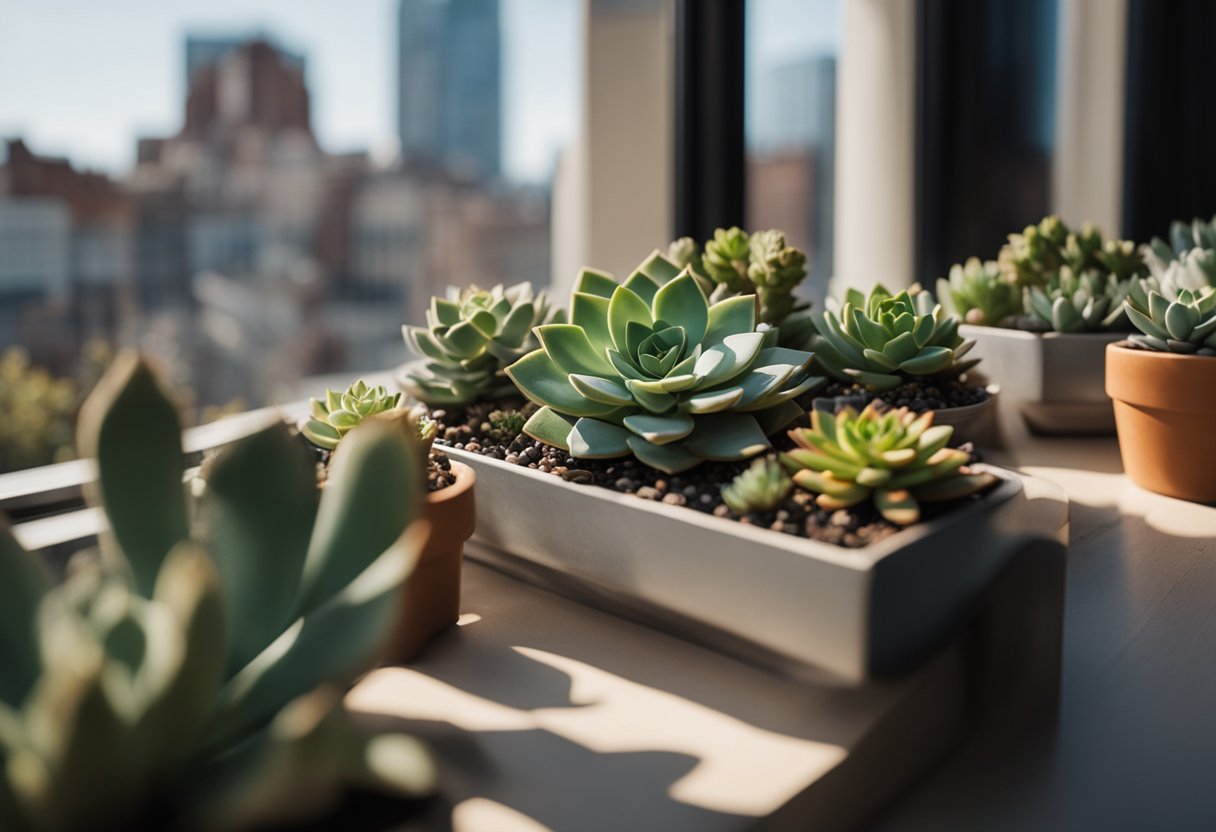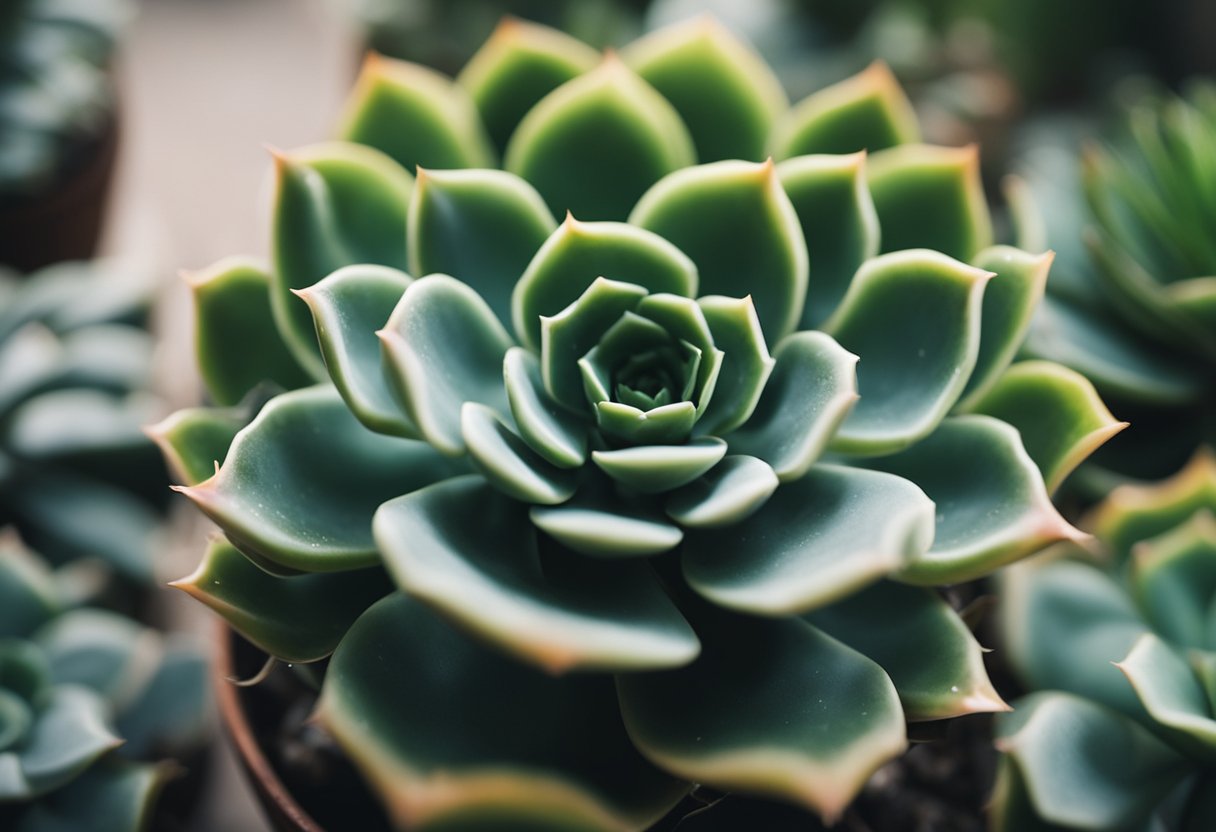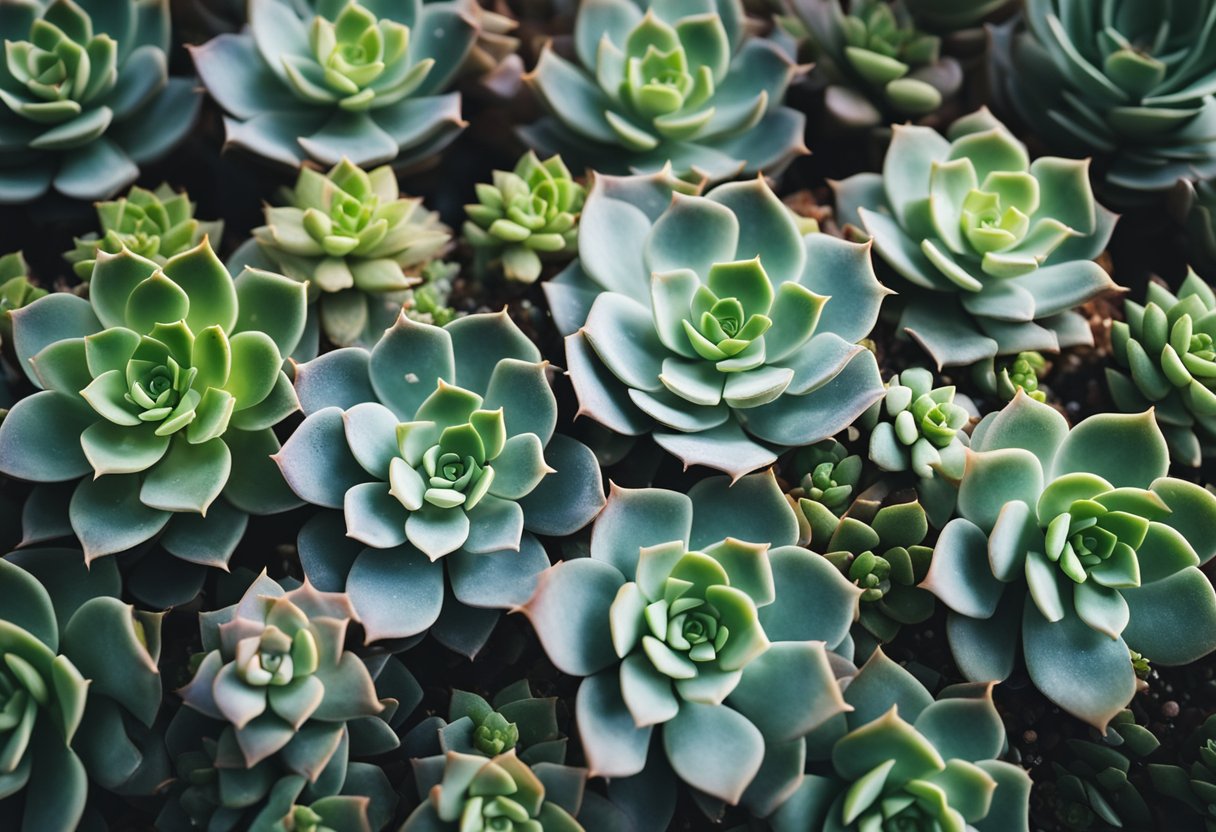Can You Be Allergic to Succulents? Exploring the Possibility of Succulent Allergies
Succulents are popular plants that are known for their ability to thrive in arid and dry conditions. They come in a wide variety of shapes, sizes, and colors, making them a favorite among gardeners and plant enthusiasts. However, some people may wonder if they can be allergic to succulents.
This post may contain affiliate links, which means I’ll receive a commission if you purchase through my link, at no extra cost to you. Please read full disclosure here.

The answer is yes, it is possible to be allergic to succulents. Like other plants, succulents produce various substances that can trigger allergic reactions in some individuals. The most common allergen found in plants, including succulents, is pollen. However, succulents do not produce much pollen, making them a safe choice for individuals with pollen allergies. Some succulents, like those in the Euphorbia family, can cause skin irritation if touched or ingested. It is important to note that not all succulents are allergenic, and the severity of an allergic reaction can vary from person to person.
Understanding Succulents

Succulents are a type of plant that are known for their ability to store water in their leaves, stems, and roots. They come in a variety of shapes, sizes, and colors, and are often used as indoor plants or in succulent gardens.
One of the benefits of succulents is that they are low-maintenance plants. They require very little water and can survive in a range of temperatures and lighting conditions. This makes them a popular choice for people who want to add some greenery to their home but don’t have a lot of time or experience caring for plants.
In addition to their aesthetic appeal, succulents are also known for their air-purifying properties. Like other plants, they absorb carbon dioxide and release oxygen, which can help improve the air quality in your home or office.
While succulents are generally not associated with allergenic properties, it’s not unheard of to experience allergic reactions to them. Some individuals may experience symptoms such as nasal congestion, runny nose, and sneezing after coming into contact with succulents.
It’s important to note that allergic reactions to succulents are relatively rare, and most people should be able to enjoy these plants without any issues. However, if you do experience symptoms after handling or being near succulents, it’s best to avoid them in the future and consult with a healthcare professional if necessary.
Common Allergic Reactions to Succulents

While succulents are generally not associated with allergenic properties, some individuals may experience allergic reactions to them. The severity of the allergy may vary depending on the exposure and the individual’s immune response.
One of the most common symptoms of succulent allergies is skin irritation. Contact with sap or latex from certain succulent plants can cause allergic contact dermatitis, which can result in a rash, itching, redness, and swelling of the skin. In severe cases, hives may also develop.
Inhaling pollen from succulent plants can also cause respiratory symptoms in sensitive individuals. Symptoms may include sneezing, coughing, wheezing, nasal congestion, eye irritation, and shortness of breath. In rare cases, succulent allergies may also lead to anaphylaxis, a severe and potentially life-threatening allergic reaction that can cause difficulty breathing, weakness, and a drop in blood pressure.
Other symptoms of succulent allergies may include upset stomach, abdominal pain, nausea, vomiting, diarrhea, fever, irregular heartbeats, mouth irritation, and severe weakness. It is worth noting that not all succulents produce the same level of irritants, and some succulents are non-toxic.
If an individual suspects they may be allergic to succulents, they should seek medical attention. A doctor can diagnose the allergy and recommend appropriate treatment, which may include antihistamines, topical creams, or in severe cases, epinephrine injections. Individuals with severe allergies may need to avoid contact with succulent plants altogether.
Specific Succulents and Allergies
While most succulents are not allergenic, some individuals may experience allergic reactions to certain compounds in these plants. The most common allergen found in plants, including succulents, is pollen. However, succulents do not produce pollen, making them a safe choice for individuals with pollen allergies.
One succulent that can cause allergic reactions is the Euphorbia family, which includes plants such as the Crown of Thorns and Poinsettia. These plants contain a milky sap that can cause skin irritation and eye irritation, and in some cases, even respiratory problems.
Aloe vera, a popular succulent known for its medicinal properties, can also cause allergic reactions in some individuals. The sap of the plant contains anthraquinones, which can cause skin irritation and allergic dermatitis.
Kalanchoe, another popular succulent, can cause skin irritation and allergic reactions in some individuals. The plant contains bufadienolides, which are toxic to both humans and animals.
The Snake Plant, also known as Mother-in-Law’s Tongue, is a popular indoor plant that can cause allergic reactions in some individuals. The plant contains saponins, which can cause skin irritation and allergic reactions.
Jade Plant, a favorite among succulent enthusiasts, can also cause allergic reactions in some individuals. The plant contains a toxic compound called bufadienolides, which can cause skin irritation and allergic reactions.
Agave, another popular succulent, can cause skin irritation and allergic reactions in some individuals. The plant contains calcium oxalate crystals, which can cause skin irritation and allergic dermatitis.
Echeveria, Hens and Chicks, String of Pearls, Sempervivum, and Gasteria are other succulents that can cause skin irritation and allergic reactions in some individuals.
Hoya Compacta, also known as Hindu Rope, is a trailing succulent that can cause skin irritation and allergic reactions in some individuals. The plant contains a sap that can cause skin irritation and allergic dermatitis.
Yucca, a succulent that is often used in landscaping, can cause skin irritation and allergic reactions in some individuals. The plant contains saponins, which can cause skin irritation and allergic reactions.
Ivy, while not a succulent, is often used in conjunction with succulents in indoor gardens. The plant can cause skin irritation and allergic reactions in some individuals. The plant contains falcarinol, which can cause skin irritation and allergic dermatitis.
It is important to note that while some succulents can cause allergic reactions, they are generally safe for most individuals. However, if you have a history of allergies or sensitive skin, it is best to avoid handling these plants and consult with a healthcare professional if you experience any allergic reactions.
Contact and Airborne Allergens
Succulents are generally not associated with allergenic properties, but some individuals may experience allergic reactions to them. Allergic reactions can be caused by contact with the plant’s sap, spines, or pollen.
People who have allergies to latex should be cautious with succulents that produce sap. The sap of some succulents, such as Euphorbia and Kalanchoe, contains latex, which can cause allergic reactions in some individuals. Symptoms of latex allergy can range from mild to severe and include itching, redness, hives, and swelling.
In addition to sap, the spines of some succulents can also cause allergic reactions. When the spines penetrate the skin, they can cause irritation, redness, and swelling. It is recommended to wear gloves when handling prickly succulents to avoid skin contact.
Succulent pollen is not a common allergen, but some people may experience pollen allergies. Pollen allergies can cause symptoms such as sneezing, runny nose, and itchy eyes. However, succulent pollen is not typically airborne, and the risk of exposure is low.
Airborne allergens associated with succulents are typically associated with dust and mold. Dust can accumulate on the leaves of succulents and cause respiratory symptoms in some individuals. Mold can also grow on the soil of potted succulents and cause respiratory problems. It is recommended to clean the leaves of succulents regularly and to avoid overwatering to prevent mold growth.
In conclusion, while succulents are generally not associated with allergenic properties, individuals may experience allergic reactions to the plant’s sap, spines, or airborne allergens such as dust and mold. It is recommended to wear gloves when handling prickly succulents, clean the leaves of succulents regularly, and avoid overwatering to prevent mold growth.
Toxicity in Succulents
Succulents are known for their low maintenance and easy-care nature, making them a popular choice for indoor and outdoor gardening. However, some people may wonder if succulents are toxic or poisonous and if they can cause allergic reactions.
Most succulents are non-toxic and harmless to humans and pets. However, some succulent species contain toxins that can be harmful if ingested or if they come into contact with the skin or eyes.
Poisonous Succulents
Some succulent species are considered poisonous and should be handled with care. These plants contain toxic substances such as alkaloids, calcium oxalate, and toxic sap, which can cause skin irritation, respiratory problems, and other health issues.
One example of a poisonous succulent is the Kalanchoe plant. This plant contains cardiac glycosides, which can cause heart problems if ingested. Another example is the Euphorbia plant, which produces a toxic sap that can cause skin irritation and eye damage.
Calcium Oxalate Crystals
Calcium oxalate is a common substance found in many plants, including succulents. This substance can cause irritation and swelling if it comes into contact with the skin or mucous membranes. Some people may also have an allergic reaction to calcium oxalate crystals.
Toxic Succulents
Some succulent species are considered toxic and can cause health problems if ingested by humans or pets. These plants contain toxins that can cause symptoms such as vomiting, diarrhea, and abdominal pain.
One example of a toxic succulent is the Sago Palm. This plant contains cycasin, a toxic substance that can cause liver failure in animals and humans. Another example is the Crown of Thorns plant, which produces a toxic sap that can cause skin irritation and eye damage.
In conclusion, while most succulents are non-toxic and safe to handle, some species can be poisonous or toxic. It is important to research the specific succulent species before adding them to your garden or home. If you have any concerns about the toxicity of a particular succulent, it is best to consult a medical professional or poison control center.
Effects on Humans and Animals
Succulents are generally considered safe for humans and animals, but some species can cause mild to severe allergic reactions. The severity of the reaction depends on the individual’s sensitivity and the amount of exposure to the plant.
Humans
Succulents can cause skin irritation, rash, itching, and redness in some people. This is usually caused by the plant’s sap or thorns. The sap of some succulents, such as Euphorbia, can cause severe skin irritation and even blistering. Ingestion of some succulents can also cause gastrointestinal problems like vomiting and diarrhea.
In rare cases, succulent allergies can cause anaphylaxis, a severe and potentially life-threatening allergic reaction. This is more common in people with a history of severe allergies.
Animals
Succulents can also cause allergic reactions in animals, especially cats and dogs. Ingestion of some succulents can cause gastrointestinal problems like vomiting and diarrhea. Some succulents can also cause skin irritation and rash in pets.
Some succulents are toxic to animals and can cause serious health problems, including death. For example, the Kalanchoe plant can cause heart problems, while the Aloe vera plant can cause kidney damage in animals.
It is important to keep succulents out of reach of pets and to seek veterinary care immediately if an animal ingests a toxic succulent.
In conclusion, while succulents are generally safe for humans and animals, some species can cause mild to severe allergic reactions and even be toxic to pets. It is important to be aware of the potential risks and take precautions to prevent exposure.
Prevention and Safety Measures
While succulents are generally safe and non-toxic, some individuals may develop allergic reactions to them. To prevent allergic reactions, it is important to take certain safety measures when handling succulents.
One of the most important safety measures is to wear protective gloves when handling succulents. Some succulent species have spines or thorns that can cause skin irritation or injury. Protective gloves can also help prevent allergic reactions in individuals with sensitive skin.
Another important safety measure is to practice proper potting and pruning techniques. When potting succulents, it is important to use well-draining soil and a pot with drainage holes to prevent overwatering and root rot. When pruning succulents, it is important to use clean and sharp tools to prevent damage to the plant and the spread of plant diseases.
Choosing non-toxic succulents is also important for individuals with pets or small children. Some succulent species can be toxic to pets and humans if ingested. It is important to research the toxicity of different succulent species before bringing them into the home.
Lastly, it is important to be aware of potential irritants in succulents. Some succulent species produce sap or other substances that can cause skin irritation or allergic reactions in some individuals. It is important to wash hands thoroughly after handling succulents and avoid touching the eyes or mouth.
By taking these safety measures, individuals can enjoy the beauty of succulents without the risk of allergic reactions or other health issues.
Medical Intervention and Treatment
If a person experiences allergic reactions to succulents, it is important to seek medical attention immediately. An allergist or healthcare professional can determine the severity of the reaction and recommend treatment options.
In some cases, the reaction may be mild, and the individual may only need over-the-counter antihistamines to relieve symptoms such as itching, swelling, or hives. However, if the reaction is severe, the individual may need emergency medical attention, including epinephrine injections, oxygen therapy, and intravenous antihistamines and cortisone.
It is also important to note that some succulents may be toxic to humans or pets. If ingested, the individual may experience symptoms such as mouth irritation, severe weakness, or even anaphylaxis. In such cases, it is important to contact a poison control center or seek medical attention immediately.
Overall, it is important to be aware of potential allergic reactions to succulents and take necessary precautions such as wearing gloves and protective clothing when handling them. If a reaction occurs, seeking medical attention promptly can help prevent further complications.